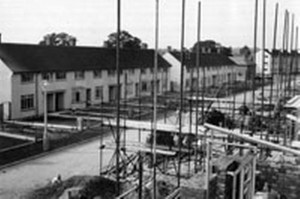It looks like Tory Councillors are following up their threat to demolish many Council house in York.
 The idea was first raised in February in a report that was rushed through the Council with little debate and no consultation.
The idea was first raised in February in a report that was rushed through the Council with little debate and no consultation.
Now an item has been placed in the Council’s forward plan which lists upcoming decisions.
It includes another opaque statement which is bound to cause concern amongst tenants. A report will recommend that the Council undertakes “a full housing stock options appraisal and at the same time develop tenant and staff panels and establish an ad-hoc cross party member scrutiny panel to consider the long term sustainability of the service and assess the different organisational governance models to support the final decision making process”.
So 15 years after tenants in York decisively rejected a move, which would have seen their homes transferred to a housing association, it looks like the idea is being revived.
For a while the neo privatisation of Council housing was a key Labour party policy. It saw several authorities in the 1990’s transfer their housing stock to housing associations. Some were relatively successful but they were outnumbered by many which completely lost contact with their tenants. Lack of accountability became -and still is – a major issue in some Cities. So called “Arms Length Management Organisations” have fared little better.
In York tenants decisively voted to remain with the Council.
While we have not been impressed with several aspects of the management of Council housing in the City over the last 5 years, we believe that a shake up in the people involved will lead to improvements.

Some communal areas are neglected by housing managers in York
Problems can be traced to a lack of attention to detail particularly in communal area maintenance and estate improvements.
Housing standards are generally good. Even the system built homes – the target of Tory criticism in February – continue to provide accommodation which is regarded as satisfactory by most occupants.
The housing account has built up a £20 million surplus although it continues to carry a £120 million historic debt burden. Council house sale levels – even after recent increases to discount rates – remain modest.
However, the Council may have to contribute towards the costs involved in the present governments scheme to discount the sale of resident’s association properties.
Successive councils have failed to use funding streams such as the new homes bonus to pay for additional Council homes. They have failed to supplement stocks by buying on the open market when prices are favourable.
The Council has in recent years also failed to support local Residents Associations and is now even consulting on reducing their influence on the use of the annual estate improvement budget.
Weaker tenant representation will make it easier for politicians to impose drastic change without proper discussion.
A meeting to discuss the – currently secret – plans will take place on 13th October.
The distribution of Council houses in York by ward is:
|
Ward
|
No Council houses |
| Acomb |
398
|
| Bishopthorpe |
66
|
| Clifton |
891
|
| Copmanthorpe |
41
|
| Dringhouses |
414
|
|
Fishergate
|
143
|
| Fulford |
120
|
| Guildhall |
723
|
| Heworth |
1258
|
| Holgate |
447
|
| Hull Rd |
698
|
| Micklegate |
568
|
| Osbaldwick |
78
|
| Rawcliffe |
19
|
| Rural West |
95
|
| Westfield |
1717
|
| Wheldrake |
44
|
| TOTAL |
7720
|
We also understand that a meeting on 29th September is likely to look again at the discredited plan to develop the garage site to the rear of Newbury Avenue.


 The York Councils Executive member with responsible for housing is being asked to write off the bad debts of 4 former Council tenants.
The York Councils Executive member with responsible for housing is being asked to write off the bad debts of 4 former Council tenants. A major new
A major new 





 development/tourism/markets has been an outstanding success. The bodies are largely self-serving and unaccountable (while still sucking in large amounts of public money).
development/tourism/markets has been an outstanding success. The bodies are largely self-serving and unaccountable (while still sucking in large amounts of public money). Confusion also surrounds the government’s plan to force Council’s to sell vacant “higher value” Council houses on the open market, to help to subsidise the sale of housing association properties to their tenants.
Confusion also surrounds the government’s plan to force Council’s to sell vacant “higher value” Council houses on the open market, to help to subsidise the sale of housing association properties to their tenants.

 The idea was first raised in
The idea was first raised in 



